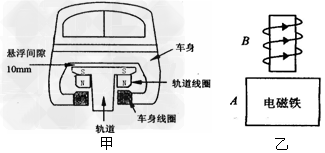阅读短文,回答问题
磁 悬 浮 列 车
磁悬浮列车是由无接触的电磁悬浮、导向和驱动系统组成的新型交通工具,是高新技术的产物。上海磁悬浮列车示范运营线项目于2006年4月26日正式通过国家竣工验收。正线全长约30km,设计最高运行时速430km/h,单向运行时间7min20s。
(1)上海磁悬浮列车的结构如图甲所示.要使列车悬浮起来,车身线圈的上端是_________极,它是利用_____________的相互作用,将车身托离轨道,大大减小了___________,使列车能高速运行。若列车总质量是20t,磁悬浮列车行驶时,强大的___________使列车上升10mm。

(2)如果列车在单向运行过程中,只停靠一站,那么,停靠时间约为_________(设磁悬浮列车全程均以360km/h的速度行驶)。
(3)图乙是另一种磁悬浮列车的设计原理图,A是磁性稳定的电磁铁,安装在铁轨上,B是安装在车身上(紧靠铁轨上方)的电阻非常小的螺线管。B中电流方向如图乙所示,请在图中标出通电螺线管的N极,螺线管B与电磁铁A之间相互_________ (选填“排斥”或“吸引”),从而使列车悬浮在铁轨上方。
(1)北 同名磁极互相排斥 摩擦 斥力(排斥力)
(2)2min20s
(3)B的下端是S极 排斥
